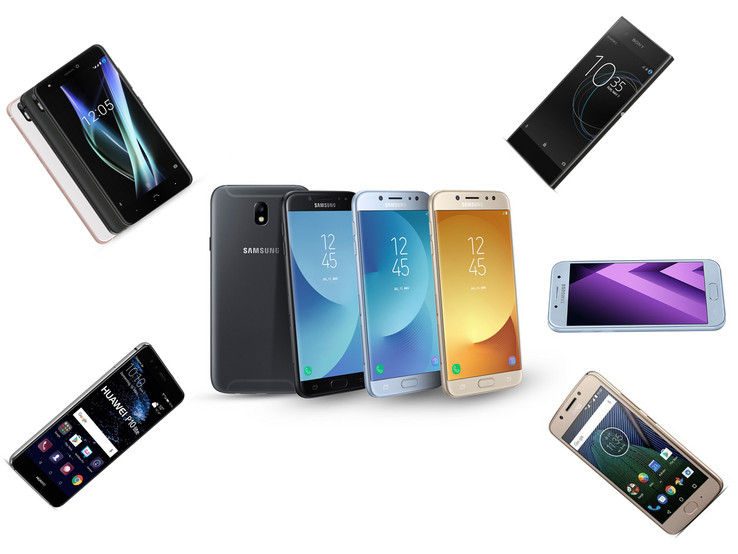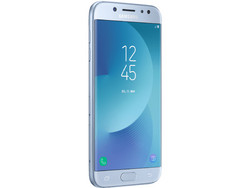The Best Samsung Galaxy J5 (2017) Alternatives
For the original German article, see here.
When the Samsung Galaxy J5 (2017) Duos was first released, it retailed for 279 Euros (~$329). Today, it can be had for as little as 200 Euros (~$235) - a steal given the balanced and coherent overall package.
However, Samsung’s competitors have been anything but idle and in the past year and this price bracket has been literally flooded with good smartphones. Take for example the Motorola Moto G5 Plus with its sleek metal case and long battery life, or the just as premium looking Huawei P10 Lite. On the other hand, Sony's Xperia XA1 features a high-resolution camera and a rather unique design. The BQ Aquaris X can be either an insider tip or a misfit, depending on your point of view. And just like last year, this year’s Samsung Galaxy A3 can be a tough contender assuming you do not mind or even prefer the smaller screen.
| Specs | Galaxy J5 (2017) | Motorola Moto G5 Plus | Huawei P10 Lite | Xperia XA 1 | BQ Aquaris X | Galaxy A3 (2017) |
|---|---|---|---|---|---|---|
| Display | 5.2“, OLED, 720p | 5.2“, IPS, 1.080p | 5.2“, IPS, 1.080p | 5.0“, IPS, 720p | 5.2“, IPS, 1.080p | 4.7“, OLED, 720p |
| SoC | Exynos 7870 | Snapdragon 625 | Kirin 658 | Helio P20 | Snapdragon 626 | Exynos 7870 |
| RAM | 2 GB | 3 GB | 4 GB | 3 GB | 3 GB | 2 GB |
| Storage | 16 GB | 32 GB | 32 GB | 32 GB | 32 GB | 16 GB |
| Dual-SIM | yes | yes | hybrid | no | hybrid | no |
| MicroSD | yes | yes | yes | yes | yes | yes |
| Fingerprint | yes | yes | yes | no | yes | yes |
| Cameras | 13 / 13 MP | 12 / 5 MP | 12 / 8 MP | 23 / 8 MP | 16 / 8 MP | 13 / 8 MP |
| Battery | 3,000 mAh | 3,000 mAh | 3,000 mAh | 2,300 mAh | 3,100 mAh | 2,350 mAh |
Case
For the 2017 model, the Galaxy J5’s case has been once again updated. Where the predecessor had nothing but a metal frame, the current model’s case is made entirely out of aluminum. Build quality and rigidity are excellent, and the phone is now also available in a light shade of Blue. Overall, the 2017 model’s design seems much more modern and fresh. Unfortunately, the battery is no longer user-replaceable, which was one of the predecessor’s main advantages.
The current 2017 J5’s footprint is mediocre at best, and with its thickness of 8 mm (~0.31 in) it is not particularly slim, especially when compared to the 7.2 mm (~0.28 in) slim Huawei P10 Lite. In general, the competition has become pretty fierce compared to last year. This is partly due to Samsung’s decision to get rid of the user-replaceable battery, thereby eliminating one of the J5’s main virtues and partly due to the upgrades the competitors have been showered with, such as for example the high-quality cases on the Motorola Moto G5 Plus or the Sony Xperia XA1. The Galaxy A3 is even IP68-certified and therefore the only dust- and waterproof phone in our comparison group.
The Galaxy J5 is the heaviest of the bunch, although admittedly it is a matter of preference whether one considers that extra weight to be high-quality or annoying. Either way, it offers a nice and firm grip and feels very good to the touch thanks to its rounded edges.
There is one thing the Galaxy J5 can do that only one other competitor, the Motorola Moto G5 Plus, is capable of: it supports two SIM cards and a microSD card at the same time. On all other smartphones, dual SIM capabilities and microSD cards are mutually exclusive.
Display, Connectivity, and Performance
The Galaxy J5’s AMOLED display is a blessing and a curse at the same time. On the one hand it offers perfect blacks and popping colors. On the other hand its maximum brightness of no more than 451 nits is fairly limited, and subsequently the J5 ends up in last place in terms of display brightness. That said, the shortfall to the Moto G5 Plus is only around 10%. Another downside is the almost archaic resolution of only 1280x720. At this price point, many competitors already offer FHD displays.
Sensitive users might find the J5’s display flicker to be yet another annoyance. It flickers at a very low frequency at reduced levels of brightness, which can cause headaches or eyestrain. If you are unsure about the display we suggest trying it out before purchasing the phone. Not a single IPS panel in our test group suffered from PWM flickering.
Color representation and white balance are excellent, colors are very accurate and without any blue tint. And alas, the J5 (2017) finally features an ambient light sensor - something every single of its competitors has been equipped with for quite some time. Maximum brightness is only available with activated ambient light sensor, whereas manual adjustment offers a slightly lower maximum level of brightness.
Performance-wise, the J5 cannot keep up with its rivals. Smartphones equipped with Qualcomm’s Snapdragon 600 series in particular are up to 40% faster in raw computing power as well as graphics prowess. The same must be said about internal storage, which is slower than on all of its competitors. Web browsing is one of the J5’s strong points, though, and Samsung has done a great job optimizing the phone accordingly.
Almost all phones in this price range feature a fingerprint reader, the Sony Xperia XA1 being the only noteworthy exception. The J5 (2017) includes NFC and fast 802.11ac Wi-Fi, which is slowly but surely trickling down into this price bracket. It is also one of the few devices with support for LTE Cat. 6 with transfer speeds of up to 300 MBit/s. That said, at a total of 11 the Moto G5 Plus supports more LTE bands than the J5. This is particularly important for users who travel frequently.
| Samsung Galaxy J5 (2017) Duos Super AMOLED, 1280x720, 5.2" | Lenovo Moto G5 Plus IPS, 1920x1080, 5.2" | Sony Xperia XA1 IPS, 1280x720, 5" | Huawei P10 Lite IPS, 1920x1080, 5.2" | BQ Aquaris X LTPS IPS , 1920x1080, 5.2" | Samsung Galaxy A3 2017 Super AMOLED, 1280x720, 4.7" | |
|---|---|---|---|---|---|---|
| Response Times | ||||||
| Response Time Grey 50% / Grey 80% * (ms) | 5.6 ? | 57 ? | 42.4 ? | 48 ? | 36.8 ? | 9 ? |
| Response Time Black / White * (ms) | 5.2 ? | 26.4 ? | 18.8 ? | 36 ? | 19.6 ? | 6 ? |
| PWM Frequency (Hz) | 240.4 | 2404 ? | 250 | |||
| Screen | ||||||
| Brightness middle (cd/m²) | 448 | 503 | 522 | 507 | 675 | 574 |
| Brightness (cd/m²) | 451 | 495 | 499 | 509 | 702 | 576 |
| Brightness Distribution (%) | 91 | 96 | 92 | 95 | 91 | 94 |
| Black Level * (cd/m²) | 0.31 | 0.74 | 0.36 | 0.59 | ||
| Colorchecker dE 2000 * | 2.7 | 6.2 | 4.2 | 5.1 | 4.5 | 2.4 |
| Colorchecker dE 2000 max. * | 9.8 | 9.8 | 11.5 | 9 | 9.1 | 3.8 |
| Greyscale dE 2000 * | 1.6 | 6.8 | 6.4 | 6.1 | 6.4 | 1.9 |
| Gamma | 2.06 107% | 2.33 94% | 2.18 101% | 2.28 96% | 2.24 98% | 2.09 105% |
| CCT | 6557 99% | 8113 80% | 7044 92% | 8143 80% | 7478 87% | 6502 100% |
| Contrast (:1) | 1623 | 705 | 1408 | 1144 | ||
| Total Average (Program / Settings) |
* ... smaller is better
| PCMark for Android - Work performance score | |
| Lenovo Moto G5 Plus | |
| Huawei P10 Lite | |
| BQ Aquaris X | |
| Samsung Galaxy J5 (2017) Duos | |
| Samsung Galaxy A3 2017 | |
| Sony Xperia XA1 | |
| AnTuTu v6 - Total Score | |
| Lenovo Moto G5 Plus | |
| BQ Aquaris X | |
| Huawei P10 Lite | |
| Sony Xperia XA1 | |
| Samsung Galaxy J5 (2017) Duos | |
| Samsung Galaxy A3 2017 | |
| 3DMark | |
| 1280x720 offscreen Ice Storm Unlimited Score | |
| BQ Aquaris X | |
| Lenovo Moto G5 Plus | |
| Sony Xperia XA1 | |
| Huawei P10 Lite | |
| Samsung Galaxy A3 2017 | |
| Samsung Galaxy J5 (2017) Duos | |
| 1280x720 offscreen Ice Storm Unlimited Graphics Score | |
| Lenovo Moto G5 Plus | |
| BQ Aquaris X | |
| Sony Xperia XA1 | |
| Huawei P10 Lite | |
| Samsung Galaxy A3 2017 | |
| Samsung Galaxy J5 (2017) Duos | |
| 1280x720 offscreen Ice Storm Unlimited Physics | |
| BQ Aquaris X | |
| Sony Xperia XA1 | |
| Lenovo Moto G5 Plus | |
| Huawei P10 Lite | |
| Samsung Galaxy A3 2017 | |
| Samsung Galaxy J5 (2017) Duos | |
| GFXBench (DX / GLBenchmark) 2.7 | |
| T-Rex Onscreen | |
| Sony Xperia XA1 | |
| BQ Aquaris X | |
| Samsung Galaxy J5 (2017) Duos | |
| Samsung Galaxy A3 2017 | |
| Lenovo Moto G5 Plus | |
| Huawei P10 Lite | |
| 1920x1080 T-Rex Offscreen | |
| Lenovo Moto G5 Plus | |
| BQ Aquaris X | |
| Sony Xperia XA1 | |
| Huawei P10 Lite | |
| Samsung Galaxy A3 2017 | |
| Samsung Galaxy J5 (2017) Duos | |
| Octane V2 - Total Score | |
| Samsung Galaxy J5 (2017) Duos | |
| BQ Aquaris X | |
| Huawei P10 Lite | |
| Lenovo Moto G5 Plus | |
| Sony Xperia XA1 | |
| Samsung Galaxy A3 2017 | |
| AndroBench 3-5 | |
| Sequential Read 256KB | |
| BQ Aquaris X | |
| Huawei P10 Lite | |
| Sony Xperia XA1 | |
| Lenovo Moto G5 Plus | |
| Samsung Galaxy J5 (2017) Duos | |
| Samsung Galaxy A3 2017 | |
| Sequential Write 256KB | |
| Lenovo Moto G5 Plus | |
| Huawei P10 Lite | |
| Sony Xperia XA1 | |
| BQ Aquaris X | |
| Samsung Galaxy J5 (2017) Duos | |
| Samsung Galaxy A3 2017 | |
| Sequential Read 256KB SDCard | |
| BQ Aquaris X | |
| Sony Xperia XA1 | |
| Samsung Galaxy A3 2017 | |
| Lenovo Moto G5 Plus | |
| Samsung Galaxy J5 (2017) Duos | |
| Huawei P10 Lite | |
| Sequential Write 256KB SDCard | |
| Sony Xperia XA1 | |
| BQ Aquaris X | |
| Lenovo Moto G5 Plus | |
| Samsung Galaxy A3 2017 | |
| Samsung Galaxy J5 (2017) Duos | |
| Huawei P10 Lite | |
Camera
Looking at the specifications, the J5’s camera is quite impressive: 13 MP main and front-facing shooters. Both cameras performed very well in our tests, and are capable of keeping up with the competition. The main camera’s flash is only single-color, compared to multi-color LED flashes on the Moto G5 Plus or the BQ Aquaris X.
The Sony Xperia XA1 features an excellent 23 MP camera with hybrid-autofocus that is way out of everybody else’s league. Its performance and picture quality is on a par with much more expensive smartphones. All things considered, the J5’s camera with its particularly impressive front-facing selfie camera performed as expected for its class.
Battery Life
Even though the battery is not user-replaceable anymore and slightly smaller in capacity to boot, the Galaxy J5 (2017) has delivered some impressive battery life results in our tests: 738 minutes (12:18 hours) in our Wi-Fi test are only bested by the Moto G5 Plus by a few minutes. In return, the G5’s battery life in all other battery benchmarks was shorter than the J5’s. The BQ Aquaris X sits at the bottom of the barrel but let’s not forget that it is significantly faster than the J5 and has a higher-resolution display to boot.
| Samsung Galaxy J5 (2017) Duos 3000 mAh | Lenovo Moto G5 Plus 3000 mAh | Sony Xperia XA1 2300 mAh | Huawei P10 Lite 3000 mAh | BQ Aquaris X 3100 mAh | Samsung Galaxy A3 2017 2350 mAh | |
|---|---|---|---|---|---|---|
| Battery runtime | ||||||
| Reader / Idle (h) | 26.1 | 20.1 | 23.9 | 23.5 | 47.7 | |
| H.264 (h) | 15.3 | 13.3 | 12.5 | 9.8 | 16.5 | |
| WiFi v1.3 (h) | 12.3 | 12.4 | 11.3 | 11.1 | 9.9 | 11.1 |
| Load (h) | 7.5 | 5.4 | 4.3 | 4.8 | 8.9 |
Verdict
Is the Samsung Galaxy J5 still the undisputed ruler of the affordable mid-range market? Tough call, but what is certain is that it is a very decent all-rounder with no real drawbacks. However, the competition has become much tougher in the past year. The Motorola Moto G5 Plus offers an all-metal case, a much faster SoC, and great battery life. The Sony Xperia XA1’s design is certainly quite unique, and its camera is out of this world.
Consequently, the J5 has started to lag behind its competitors in some areas, such as its low-resolution display, its meager storage capacity, or its battery that is no longer user-replaceable. At least the current model features an ambient light sensor, which has been fairly common in other smartphones for a very long time. The fingerprint reader is also a necessity and therefore a mandatory upgrade at this point.
The question is: why does the J5 remain so popular? Its high-quality case, optimized software, and a highly efficient mode of operation add up and make for a very balanced and well-adjusted overall impression. And sometimes it is the little things, like its Dual SIM capabilities or the slightly recessed and therefore protected camera. If you are looking for a solid and sound mid-range smartphone, the Galaxy J5 (2017) should definitely be on your list.
The Samsung Galaxy J5 (2017) is certainly not unbeatable, but it is a very balanced and well-adjusted lower mid-range smartphone.
If you require more power go for the Motorola Moto G5 Plus. If you need a better camera, the Sony Xperia XA1 will become your best friend. If you prefer a breeze of flagship charm you might want to take a closer look at the Huawei P10 Lite. And last but not least the BQ Aquaris X is a very interesting albeit exotic alternative.











